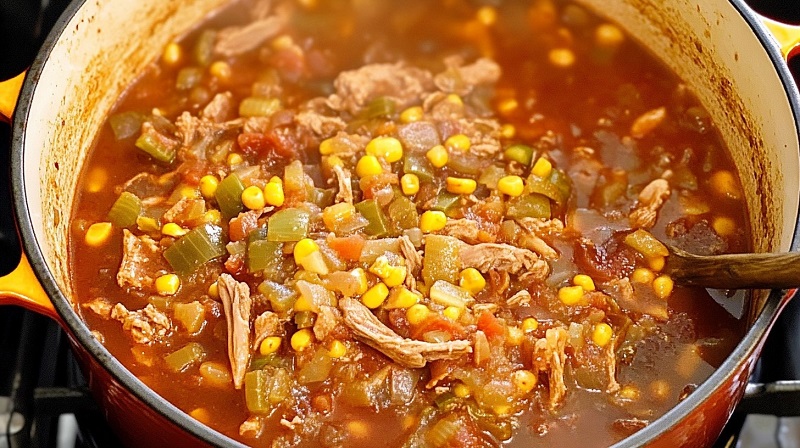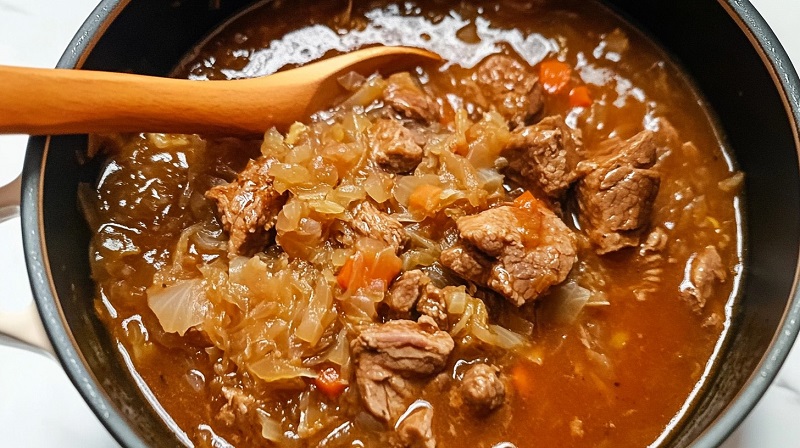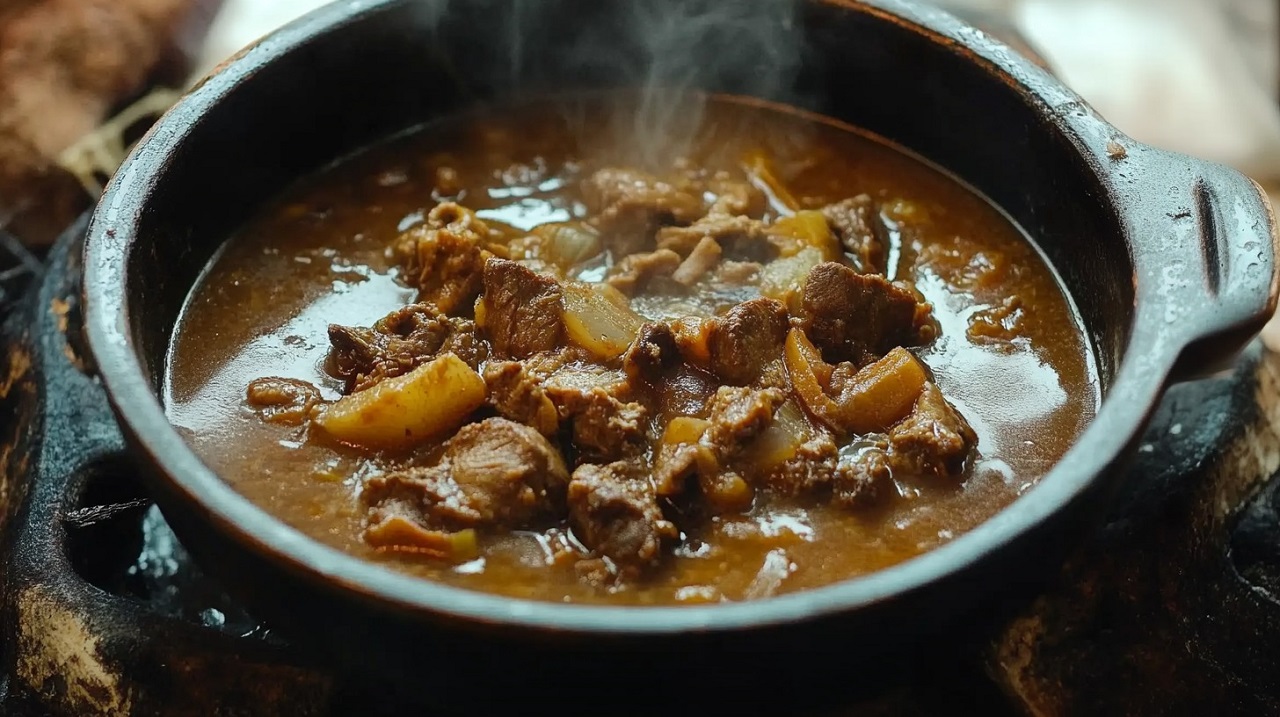The Appalachian Mountains offer a unique blend of rich history and rustic flavors in every meal. Soups and stews from this region are crafted with simple ingredients, often sourced from local farms and forests. These comforting dishes have been passed down through generations, providing nourishment and warmth during the cold months.
The heart of Appalachian cuisine lies in its ability to turn everyday ingredients into something special, bringing people together for meals that are as satisfying as they are flavorful. Enjoy the comforting essence of the Appalachian way with every bite.
Brunswick Stew

Brunswick Stew is an iconic dish from the Appalachian region, rich in history and flavor. Originally a southern dish, it has become a staple across the Appalachian Mountains. This stew blends tender meat with vegetables, creating a hearty, savory meal.
The deep smoky flavor, typically achieved through slow-cooking meats like chicken and pork, gives Brunswick Stew a distinct, satisfying taste. It’s perfect for those who enjoy a balance of rich, comforting flavors with a hint of smokiness.
Ingredients
- 1 lb chicken (bone-in, skinless)
- 1 lb pork shoulder (cut into chunks)
- 1 onion, chopped
- 1 can of diced tomatoes
- 2 cups corn kernels (fresh or frozen)
- 2 cups lima beans (fresh or frozen)
- 4 cups chicken broth
- 2 tablespoons apple cider vinegar
- 1 tablespoon Worcestershire sauce
- 1 teaspoon smoked paprika
- Salt and pepper to taste
- Hot sauce (optional)
Instructions
- In a large pot, combine the chicken, pork, and broth. Bring to a boil, then reduce the heat and simmer for 1.5 to 2 hours, until the meats are tender and fully cooked.
- Remove the meats, shred them, and return the meat to the pot.
- Add the chopped onion, diced tomatoes, corn, and lima beans to the pot. Stir in the apple cider vinegar, Worcestershire sauce, smoked paprika, salt, and pepper.
- Let the stew simmer for another 45 minutes, stirring occasionally. If you prefer a spicier kick, add hot sauce to taste.
- Adjust seasoning as needed, and serve hot.
Brunswick Stew stands out as one of the most fulfilling meals I’ve ever had. The smokiness from the slow-cooked meats pairs wonderfully with the sweetness of corn and the creamy texture of lima beans. It’s a perfect meal for cooler days, and its simplicity doesn’t take away from its depth of flavor. I love how versatile it can be—whether you use leftovers from a roasted chicken or slow-cook the pork for hours, the result is always comforting. If you haven’t tried it, you’re missing out on a true Appalachian treasure.
Brunswick Stew isn’t just a meal; it’s a tradition. It carries the essence of the Appalachian Mountains, where every spoonful tells a story of resourcefulness, family, and slow-cooked goodness. I encourage you to give this recipe a try and make it your own, whether you stick to tradition or experiment with new flavors. It’s a dish meant to be shared with family and friends, and I’m sure it’ll become a favorite in your household as it is in many Appalachian kitchens.
Ham and Beans

Ham and Beans is a no-frills, hearty dish that is beloved in the Appalachian Mountains. Simple in nature yet packed with flavor, it combines salty, smoky ham with tender beans to create a filling and satisfying meal.
It’s the kind of comfort food that doesn’t need anything extra to impress. What makes Ham and Beans so special is its ability to bring out the natural flavors of the ingredients, especially when the ham is slowly simmered to perfection. It’s a dish that warms the soul and brings a feeling of home.
Ingredients
- 1 lb dried navy beans (or any bean variety you prefer)
- 1 ham bone (or 1 lb ham hock)
- 1 onion, chopped
- 2 cloves garlic, minced
- 1 teaspoon thyme
- 1 bay leaf
- 4 cups chicken broth
- Salt and pepper to taste
Instructions
- Rinse the dried beans and soak them in water overnight. If you’re short on time, a quick soak method (boil for 2 minutes, then let them sit for 1 hour) works as well.
- In a large pot, add the soaked beans, ham bone or ham hock, chopped onion, garlic, thyme, and bay leaf. Pour in the chicken broth and bring to a boil.
- Reduce the heat and simmer the stew for 2-3 hours, stirring occasionally, until the beans are tender and the flavors meld together.
- Once cooked, remove the ham bone or hock, shred any remaining ham, and return it to the pot.
- Season with salt and pepper to taste, and serve hot.
Ham and Beans is the definition of comfort food. The combination of tender beans and rich, salty ham creates a balance that is both hearty and satisfying. It’s also one of the easiest dishes to make but never fails to impress.
The long simmering time allows the flavors to meld, creating a deep, savory broth that’s perfect with cornbread on the side. If you’re looking for a meal that’s as comforting as a warm blanket on a cold day, Ham and Beans is a must-try.
There’s something about a bowl of Ham and Beans that instantly feels like home. It’s a dish that doesn’t require much effort but delivers on every front. I encourage you to give this recipe a try, especially if you’re craving something simple yet rich in flavor. It’s a perfect dish to make in bulk, so don’t hesitate to double the recipe for leftovers.
Mutton Stew

Mutton Stew is one of the more traditional dishes from the Appalachian region, often associated with the mountain people’s resourcefulness. It’s a dish that takes its time to develop rich flavors, especially with the deep, earthy taste of mutton.
Unlike lamb, mutton has a stronger, more robust flavor, making it perfect for slow cooking. This stew is comforting and full of depth, offering a hearty, satisfying meal that’s perfect for cooler days. While it might not be as commonly found today, mutton stew remains a piece of Appalachian culinary history.
Ingredients
- 2 lbs mutton (cut into chunks)
- 1 onion, chopped
- 3 carrots, peeled and chopped
- 3 potatoes, peeled and diced
- 3 cloves garlic, minced
- 2 cups beef broth (or water)
- 1 teaspoon dried thyme
- 1 teaspoon rosemary
- 1 bay leaf
- Salt and pepper to taste
- 2 tablespoons olive oil
Instructions
- In a large pot, heat the olive oil over medium-high heat. Add the mutton chunks and brown on all sides. Remove the meat and set it aside.
- In the same pot, add the chopped onion and garlic, cooking until they soften and become fragrant, about 3 minutes.
- Return the mutton to the pot, then add the carrots, potatoes, beef broth, thyme, rosemary, bay leaf, salt, and pepper.
- Bring to a boil, then reduce the heat to low. Cover and simmer for 2 to 3 hours, until the meat is tender and the flavors meld together.
- Remove the bay leaf before serving. Adjust seasoning as needed.
Mutton Stew is a dish with a rich, hearty flavor that really grows on you. The mutton’s boldness works well with the vegetables, and the slow cooking process ensures every ingredient is infused with the deep, savory broth. It’s one of those stews that requires patience but rewards you with an incredibly satisfying meal. I particularly enjoy the balance of flavors; the herbs and vegetables perfectly complement the strong taste of mutton. If you’ve never tried mutton before, this is a great way to experience it in all its glory.
Mutton Stew may not be a regular on your dinner table, but it’s a dish that tells the story of Appalachian tradition and resourcefulness. It’s simple, rustic, and full of flavor.
Pork and Sauerkraut Stew

Pork and Sauerkraut Stew is a dish that carries the essence of Appalachian simplicity while delivering bold, tangy flavors. It is a perfect balance of tender pork and the sharpness of sauerkraut, with a hearty base that comes together beautifully after slow cooking.
While this dish might sound unusual to some, it’s an absolute comfort food for many in the Appalachian region. The acidity from the sauerkraut helps cut through the richness of the pork, creating a savory, slightly tangy stew that warms you from the inside out.
Ingredients
- 2 lbs pork shoulder (cut into chunks)
- 1 onion, chopped
- 1 clove garlic, minced
- 1 cup apple cider
- 4 cups chicken broth
- 1 tablespoon caraway seeds (optional)
- 2 cups sauerkraut (drained and rinsed)
- 3 medium potatoes, peeled and diced
- Salt and pepper to taste
- 1 tablespoon olive oil
Instructions
- In a large pot, heat the olive oil over medium-high heat. Brown the pork chunks on all sides. Remove the pork and set it aside.
- Add the chopped onion and garlic to the pot, cooking until they soften, about 3 minutes.
- Return the pork to the pot and add the apple cider, chicken broth, caraway seeds, sauerkraut, and potatoes.
- Bring to a boil, then reduce the heat to low. Cover and simmer for 1.5 to 2 hours, until the pork is tender and the flavors meld together.
- Season with salt and pepper to taste. Serve hot.
Pork and Sauerkraut Stew is a unique dish that really showcases the region’s flavors in a distinctive way. The tartness of the sauerkraut combines so well with the tender pork, making it a perfect meal for a cool evening. I love how this dish feels both rustic and comforting, especially with the soft potatoes that soak up all the wonderful broth. If you’re someone who enjoys hearty, slightly tangy dishes, this stew will definitely become a favorite.
Pork and Sauerkraut Stew might be a little unexpected if you’re not familiar with Appalachian cooking, but I encourage you to give it a try. It’s one of those dishes that may seem unusual at first, but once you taste it, you’ll appreciate the balance of flavors.
Grits and Greens Stew

Grits and Greens Stew is a true reflection of Appalachian comfort food at its finest. Combining creamy grits with flavorful greens like collard or mustard greens, this dish offers a wholesome, hearty meal that is both nourishing and satisfying.
The texture of the grits pairs perfectly with the slight bitterness of the greens, creating a balance of flavors that makes this stew a beloved choice in the region. It’s simple, rustic, and can be easily adjusted to suit your preferences, but the foundation of this dish is the richness and heartiness it provides.
Ingredients
- 1 cup grits (stone-ground preferred)
- 1 lb collard greens (or mustard greens), chopped
- 1 onion, chopped
- 2 cloves garlic, minced
- 4 cups vegetable broth
- 1 teaspoon smoked paprika
- 1 tablespoon apple cider vinegar
- Salt and pepper to taste
- 2 tablespoons olive oil
Instructions
- In a large pot, heat the olive oil over medium heat. Add the onion and garlic, and sauté until softened, about 3 minutes.
- Add the chopped greens to the pot, cooking until they begin to wilt.
- Stir in the vegetable broth, smoked paprika, and apple cider vinegar. Bring to a boil, then reduce the heat and let it simmer for about 30 minutes, until the greens are tender.
- While the greens simmer, cook the grits according to package instructions.
- Once the greens are cooked, stir in the cooked grits and season with salt and pepper to taste. Simmer together for 10-15 minutes, allowing the flavors to meld.
- Serve hot and enjoy.
Grits and Greens Stew is a dish that perfectly embodies Appalachian cooking—hearty, flavorful, and uncomplicated. The combination of creamy grits and savory greens makes for a deeply satisfying meal that sticks with you.
I love how versatile it is, too; you can adjust the bitterness of the greens to suit your taste, and the grits bring an amazing creaminess that ties everything together. If you’re craving something truly comforting, this stew is an ideal choice.
If you’re unfamiliar with Grits and Greens Stew, I highly recommend trying it. It’s a classic Appalachian dish that’s as wholesome as it is delicious.
FAQs
What type of beans are best for Ham and Beans Stew?
Navy beans, great northern beans, or pinto beans work well for Ham and Beans Stew. These beans cook down nicely and create a creamy texture.
Can I substitute pork for mutton in Mutton Stew?
Yes, you can substitute pork for mutton. While mutton has a stronger flavor, pork can provide a similar richness to the stew.
Is there a vegetarian version of Brunswick Stew?
Yes, you can make a vegetarian Brunswick Stew by replacing the meats with vegetables like potatoes, corn, and beans, and using vegetable broth instead of chicken or beef broth.
How long can I store leftovers of Pork and Sauerkraut Stew?
Leftovers can be stored in an airtight container in the fridge for up to 3-4 days. For longer storage, it can be frozen for up to 3 months.
Can I make Grits and Greens Stew with frozen greens?
Yes, frozen greens can be used in place of fresh greens. Just be sure to thaw and drain them before adding to the stew to avoid excess water.
Last Words
Appalachian soups and stews are a true reflection of the region’s rich culinary heritage. Simple, hearty, and full of flavor, they bring comfort and warmth to any table. Whether you’re trying a classic like Brunswick Stew or exploring something new like Grits and Greens Stew, these dishes are perfect for sharing with loved ones.
Enjoy these traditional recipes and let them bring a taste of the Appalachian Mountains to your kitchen.
Read next: Venison vs. Beef – Which is the Healthier and Tastier Choice?

